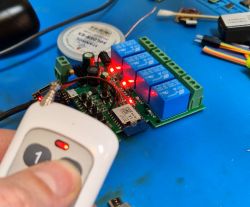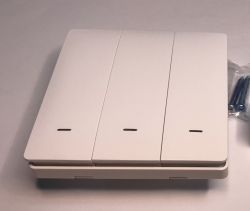FAQ
TL;DR: To set up the TYEB 4CH‑RF with OpenBeken, pick the right chip (2 variants) and “Choose correct platform for your firmware.” Back up before flashing, then apply the GPIO map shown below. [Elektroda, p.kaczmarek2, post #20558276]
Why it matters: This FAQ helps CB3S/WB3S owners fix flashing errors and reliably configure all channels and buttons.
Quick Facts
- Flashing method: attach a USB‑to‑UART adapter to the CB3S module to burn OpenBeken. [Elektroda, p.kaczmarek2, post #20557208]
- GPIO map: Relays P24/P6/P26/P14; Buttons P8–P11; WiFi LED P22; Pair/All P7. [Elektroda, p.kaczmarek2, post #20558834]
- Ready config: paste the provided OBK JSON via Web App → Import to speed setup. [Elektroda, p.kaczmarek2, post #20558834]
- Useful features: PowerSave 1 lowers energy use; startDriver SSDP enables Windows Network discovery. [Elektroda, p.kaczmarek2, post #20559686]
- Tip: isolate TX/RX lines during updates to avoid bus contention on some boards. [Elektroda, kinziulisKinziulisLT, post #20558439]
How do I configure the TYEB 4CH‑RF in OpenBeken?
Assign GPIOs per the known map. Relays: P24, P6, P26, P14. Buttons: P8, P9, P10, P11. WiFi LED: P22 using WifiLED_n. Set P7 as Btn_Tgl_All to toggle all channels or pair. You can also import the posted JSON via Web App → Import. [Elektroda, p.kaczmarek2, post #20558834]
Where is Relay 4 (CH4) GPIO?
Relay 4 is on P14. In OpenBeken, set P14 to Rel;4 to control channel 4. This completes the 4‑relay map (CH1–CH4). [Elektroda, p.kaczmarek2, post #20558834]
Which GPIOs are the local buttons and the Pair/Toggle‑All input?
Buttons are on P8, P9, P10, and P11 (Btn;1–Btn;4). The Pair/Toggle‑All input is P7. Map it as Btn_Tgl_All;0 to toggle all relays or enter pairing. [Elektroda, p.kaczmarek2, post #20558834]
How do I flash OpenBeken on a CB3S without errors?
- In your flasher, select BK7231N for CB3S (WB3S uses BK7231T).
- Read a full backup before writing any new image.
- Write the firmware and reboot to complete.
“Please choose correct platform for your firmware, BK7231T for WB3S, and BK7231N for CB3S.” [Elektroda, p.kaczmarek2, post #20558276]
Which pins do I wire for USB‑UART flashing on CB3S?
Open the case to access the CB3S module and attach a USB‑to‑UART adapter. Use it to burn the OpenBeken firmware to the module as instructed. This board is designed to be flashed over UART. [Elektroda, p.kaczmarek2, post #20557208]
I get “Getting bus failed” when flashing—what should I try?
Isolate the UART lines from the rest of the circuit during the update. Disconnect or cut the on‑board TX/RX paths so the adapter has exclusive access, then retry flashing. Reconnect once flashing succeeds. [Elektroda, kinziulisKinziulisLT, post #20558439]
Why does my Tuya backup read as an “invalid BK device image”?
This occurs if you erase before backing up or use the wrong platform. Do not erase first. Verify the correct platform (BK7231N for CB3S, BK7231T for WB3S), then read a backup and proceed. “Please do not erase before doing backup.” [Elektroda, p.kaczmarek2, post #20558276]
Can the 433 MHz RF on the TYEB 4CH‑RF be used with OpenBeken?
The shared GPIO map does not assign any RF input, so RF isn’t enabled by that config. To use RF, you must identify the RF receiver hardware and its data pin, then map or add support. The thread does not post a working RF setup. [Elektroda, p.kaczmarek2, post #20558834]
WiFi sometimes stops working until power‑cycling—how do I diagnose it?
First confirm you flashed the correct platform. Reflash with BK7231N for CB3S (or BK7231T for WB3S) if uncertain. Always back up before changes. Platform mismatch or a bad image can cause instability. “Please choose correct platform for your firmware.” [Elektroda, p.kaczmarek2, post #20558276]
Where can I get a ready‑to‑import OpenBeken JSON for this board?
Use the JSON posted in the thread. Open the OpenBeken Web App, go to Import, and paste the provided JSON to auto‑assign pins and LED. [Elektroda, p.kaczmarek2, post #20558834]
How do I set up the WiFi LED?
Assign P22 to WifiLED_n in OpenBeken. The “_n” indicates active‑low, so the LED turns on when the pin is low. This maps the on‑board WiFi indicator correctly. [Elektroda, p.kaczmarek2, post #20558834]
What’s the simplest way to toggle all four relays with one button?
Map P7 as Btn_Tgl_All;0. A press toggles all channels together, and the pin can also serve for pairing modes if supported. This complements the per‑channel buttons. [Elektroda, p.kaczmarek2, post #20558834]
What’s the difference between CB3S and WB3S when flashing?
CB3S uses BK7231N, while WB3S uses BK7231T. Choose the matching platform in your flasher or the image will be wrong. “BK7231T for WB3S, and BK7231N for CB3S.” [Elektroda, p.kaczmarek2, post #20558276]
K1/K2 don’t work on my 85–250 V version—what should I check?
That variant may have different wiring. One user reported K1/K2 inoperative on the 85–250 V board and shared a backup. Compare or extract its GPIOs, then remap your config accordingly. Hardware revisions can change pin assignments. [Elektroda, kinziulisKinziulisLT, post #20597618]
Can you extract my GPIO map from a firmware backup?
Yes. Provide a full 2 MB backup from a Tuya‑flashed unit, and the GPIO configuration can be extracted for pin mapping. This accelerates correct relay and button setup. [Elektroda, p.kaczmarek2, post #20557638]
How can I save energy and make the switch discoverable on Windows?
Enable PowerSave 1 to reduce energy use and run startDriver SSDP for Windows discovery. Add them to startup or autoexec.bat. “startDriver SSDP to make device visible in Windows network places.” [Elektroda, p.kaczmarek2, post #20559686]









